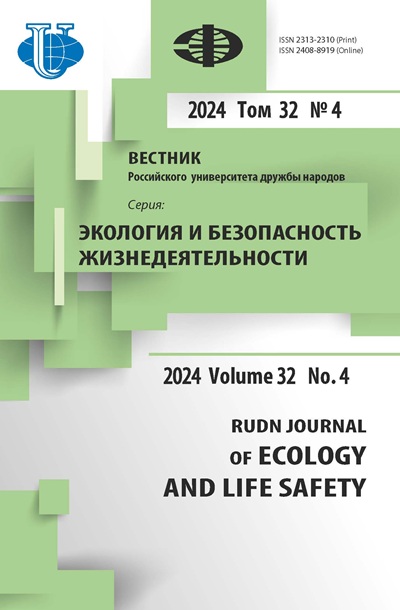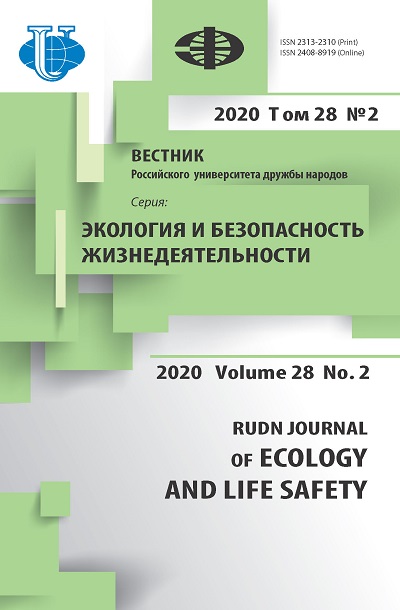Use of activated peat for remediation of soils contaminated with petroleum products
- Authors: Adelfinskaya E.A.1, Myazin V.A.2
-
Affiliations:
- ITMO National Research University
- Institute of Industrial Ecology of the North - a separate division of the Federal Research Center “Kola Scientific Center of the Russian Academy of Sciences”
- Issue: Vol 28, No 2 (2020)
- Pages: 160-171
- Section: Ecology
- URL: https://journals.rudn.ru/ecology/article/view/25644
- DOI: https://doi.org/10.22363/2313-2310-2020-28-2-160-171
Cite item
Full Text
Abstract
One of the most serious environmental problem in the Far North of the Russian Federation is the pollution of the territory by oil and oil products. Ecosystems of this region are extremely vulnerable, their remediation after anthropogenic impact, such as spill of fuels, can last for decades. This is the reason for necessity of the development of effective methods for cleaning and restoring oil-contaminated lands. As a result of undertaken laboratory study, the possibility of bioremediation of soils contaminated with oil products using activated peat as a sorbent and organic fertilizer was shown. Two weeks after the addition of activated peat, the content of petroleum hydrocarbons in the soil decreased by 22-47% due to dilution of pollution and improvement of air and nutrient regime. After reclamation, the germination rate of the seeds of a test culture increased by 1,6-3,7 times. The optimum amount of peat required for adding into contaminated sandy soil, depending on the degree of contamination, has also been established. Based on the studies, recommendations for the remediation of the contaminated area of 0.07 ha located in the north-west of the Murmansk region using peat and mineral fertilizers were developed.
Keywords
About the authors
Ekaterina A. Adelfinskaya
ITMO National Research University
Author for correspondence.
Email: adelfinskayakate19@gmail.com
master student of the Department of Industrial Ecology and Clean Production
49 Kronverkskii Ave, lit. A, Saint Petersburg, 197101, Russian FederationVladimir A. Myazin
Institute of Industrial Ecology of the North - a separate division of the Federal Research Center “Kola Scientific Center of the Russian Academy of Sciences”
Email: myazinv@mail.ru
Candidate of Biological Sciences, senior researcher
14А, Akademgorodok, Apatity, 184209, Russian FederationReferences
- Seredina VP, Andreeva TA, Alekseeva TP, Burmistrova TI, Tereshchenko NN. Neftezagryaznennye pochvy: svoistva i rekul'tivatsiya [Oil-contaminated soils: properties and remediation]. Tomsk: TPU Publ.; 2006.
- Namkoong W, Hwang EY, Park JS, Choi JY. Bioremediation of diesel-contaminated soil with composting. Environ. Pollut. 2002;(119):23–31.
- Abioye PO, Aziz AA, Agamuthu P. Enhanced biodegradation of spent motor oil in soil amended with organic wastes. Water Air Soil Pollut. 2010;(209):173–179.
- Onibon VO, Fagbola O. Evaluation of bioremediation efficiency of crude oil-polluted soils as influenced by application of composts and NPK fertilizer. Fres. Environm. Bull. 2013;(22):61–66.
- Arno OB, Arabskii AK, Bashkin VN, Galiulin RV, Galiulina RA, Alekseev AO, Salbiev TX-M, Serebryakov EP. Patent 2611159 of the Russian Federation. Sposob otsenki effektivnosti rekul'tivatsii posredstvom torfa narushennykh tundrovykh pochv s razlichnoi polnoi vlagoemkost'yu [Method for assessing the effectiveness of reclamation by means of peat of disturbed tundra soils with different moisture capacity]. Bull. Invent. 2017. No. 6.
- GOST R 57447-2017. Nailuchshie dostupnye tekhnologii. Rekul'tivatsiya zemel' i zemel'nykh uchastkov, zagryaznennykh neft'yu i nefteproduktami. Osnovnye polozheniya [The best technology available. Reclamation of lands contaminated with oil and oil products. The main provisions]. Moscow: Standartinform Publ.; 2019.
- Chukhareva NV, Shishmina LV. Comparison of the sorption properties of peat of high and low types with respect to marketable oil and stable gas condensate. Chemistry of plant raw materials. 2012;(4):193–200.
- Burmistrova TI, Alekseeva TP, Stakhina LD, Seredina VP. The study of peat properties to solve environmental problems. Chemistry of plant materials. 2009;(3):157–160.
- Galiulin RV, Bashkin VN, Galiulina RA. The decomposition of oil hydrocarbons in the soil under the action of peat compost. Chemistry of solid fuels. 2012;(5):52–53.
- Burmistrova TI, Alekseeva TP, Perfilieva VD, Tereshchenko NN, Stakhina LD. Biodegradation of oil and oil products in soil using ameliorants based on activated peat. Chemistry of plant raw materials. 2003;(3):69–72.
- Adelfinskaya EA, Belyaev AM. A study of the effectiveness of the microbiological stage of reclamation of oil-contaminated lands. Bulatov readings. 2018;(5):41–45.
- PND F 16.1: 2.2.22-98. Kolichestvennyi khimicheskii analiz pochv. Metodika vypolneniya izmerenii massovoi doli nefteproduktov v mineral'nykh, organogennykh, organomineral'nykh pochvakh i donnykh otlozheniyakh metodom IK-spektrometrii [Quantitative chemical analysis of soils. Methodology for measuring the mass fraction of petroleum products in mineral, organogenic, organomineral soils and bottom sediments by IR-Spectrometry]. Moscow; 2006.
- Mineev VG. Opredelenie aktivnosti degidrogenazy. Praktikum po agrokhimii [Determination of dehydrogenase activity. Workshop on agrochemistry]. 2nd ed. Moscow: Publishing House of Moscow State University; 2001.
- Gaponyuk EI, Malakhov SV. Kompleksnaya sistema pokazatelei ekologicheskogo monitoringa pochv [Integrated system of indicators for environmental monitoring of soils]. Migratsiya zagryaznyayushchikh veshchestv v pochvakh i sopredel'nykh sredakh [Migration of pollutants in soils and adjacent environments]: proceedings of the 4th All-Union conference. Leningrad: Gidrometeoizdat Publ.; 1985. p. 3–10.
















